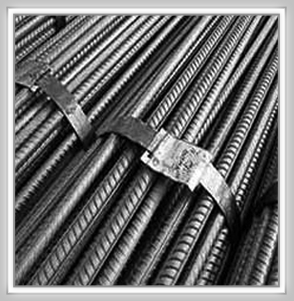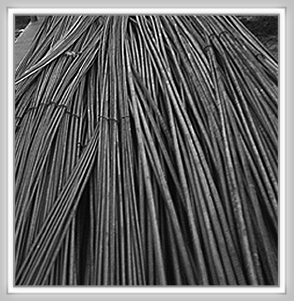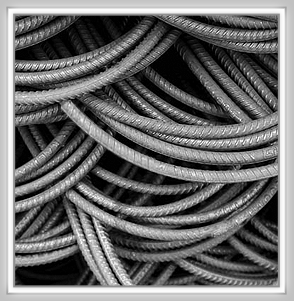| |
| |
| TMT TURBO QUENCH BARS |
Strength of the bars are carefully controlled by optimizing the water pressure for their pearlitic core and tough surface of tempered martensite, thereby providing an optimum strength, ductility and toughness. TMT bars are widely used in general purpose concrete reinforcement structures, bridges and flyovers, dams, thermal and hydel power plants, industrial structures, high-rise buildings, underground platforms in metro railway and rapid transport system. TMT Bars are thermo-mechanically-treated through leading world TurboQuench based technology for high yield strength. The process involves rapid quenching of the hot bars through a series of water jets after they roll out of the last mill stand. The bars are cooled, allowing the core and surface temperatures to equalize. The bar core cools down slowly to turn into a ferrlite-pearlite aggregate. Vardhman Adarsh Ispat unit has been authorized by Herbert Rothe to manufacture TMT Turbo Quench.
|
|
| Product Catagories |
Vardhman’s high quality reinforcement bars are produced at most advanced fully automatic, high speed rolling mill through “Quenching & Tempering Process”. The rebars produced are far better than the traditionally produced rebars in India.
Bars are rolled in the following specification :
Grades |
Fe- 415, Fe - 500, Fe –550 , 415D , 500D , 550D |
Diameter |
8,10,12,16,20,25 MM (28 and 32 min. On bulk demand) |
Standard Length |
11 mtrs. To 13 mtrs. |
The TMT bars manufactured fully conform to IS-1786 : 1985 and are produced by adopting the most modern and advanced technology.
These TMT bars provide extra strength for extra safety for high rise buildings, flyovers,bridges, hotels and factories.
|
| Features of TMT Bars |
1. Enhanced strength combined with high ductility
2. Excellent weldability without loss of strength at welded joints
3. Better ductility and malleability
4. Earthquake resistant due to high tensile strength
5. High thermal resistance
6. Significant savings in cost of steel |
|
Chemical Composition |
The ladle analysis of steel for various grades , when made as per ISI-1786 shall have maximum permissible percentage of constituents as follows :
Constituent
|
Percentage, Maximum |
|
Fe 415 |
Fe 415D |
Fe 500 |
Fe 500D |
Fe 550 |
Fe 550D |
Carbon |
0.30 |
0.25 |
0.30 |
0.25 |
0.30 |
0.25 |
Sulphur |
0.060 |
0.045 |
0.055 |
0.040 |
0.055 |
0.040 |
Phosphorus |
0.060 |
0.045 |
0.055 |
0.040 |
0.050 |
0.040 |
Sulphur& Phosphorus |
0.110 |
0.085 |
0.105 |
0.075 |
0.100 |
0.075 |
|
PROPERTIES/COMPOSITION |
INDIA (IS 1786) |
KAMDHENU TMT |
| |
|
|
MECHANICAL PROPERTIES |
Grade Fe - 415 |
Grade Fe - 415 -K |
Proof Stress ( Min.) |
415 N/mm2 |
450 N/mm2 |
Tensile Strength (Min.) |
485 N/mm2 |
530 N/mm2 |
Elongation (Min.) |
14.50 % |
20 % |
Bend Test (Min.) |
Upto 22MM-3D |
Upto 22MM-2D |
CHEMICAL COMPOSITION (%) |
|
|
Carbon |
0.30 Max. |
0.30 Max. |
Sulphur |
0.06 Max. |
0.06 Max. |
Phosphorus |
0.06 MAx. |
0.06 MAx. |
S+P |
0.11 Max. |
0.11 Max. |
MECHANICAL PROPERTIES |
Grade Fe - 500 |
Grade Fe -500 -K |
Proof Stress ( Min.) |
500 N/mm2 |
530 N/mm2 |
Tensile Strength (Min.) |
545N/mm2 |
600N/mm2 |
Elongation (Min.) |
12 % |
16 % |
Bend Test (Min.) |
Upto 22MM-4D |
Upto 22MM-3D |
CHEMICAL COMPOSITION (%) |
|
|
Carbon |
0.30 Max. |
0.17-0.24 % |
Sulphur |
0.06 Max. |
0.05 Max. |
Phosphorus |
0.06 MAx. |
0.05 Max. |
S+P |
0.105 Max. |
0.095 Max. |
Mn. |
|
0.5 Max. |
Si |
|
0.4 Max. |
MECHANICAL PROPERTIES |
Grade Fe -550 |
Grade Fe -550 -K |
Proof Stress ( Min.) |
550 N/mm2 |
575 N/mm2 |
Tensile Strength (Min.) |
585N/mm2 |
650N/mm2 |
Elongation (Min.) |
8 % |
14 % |
Bend Test (Min.) |
Upto 22MM-5D |
Upto 22MM-4D |
CHEMICAL COMPOSITION (%) |
|
|
Carbon |
0.30 Max. |
0.17-0.24 |
Sulphur |
0.055 Max. |
0.045 Max. |
Phosphorus |
0.050 MAx. |
0.045 Max. |
S+P |
0.100 Max. |
0.090 Max. |
Mn. |
|
0.5 Max. |
Si |
|
0.4 Max. |
|
|
|
|
 |

















